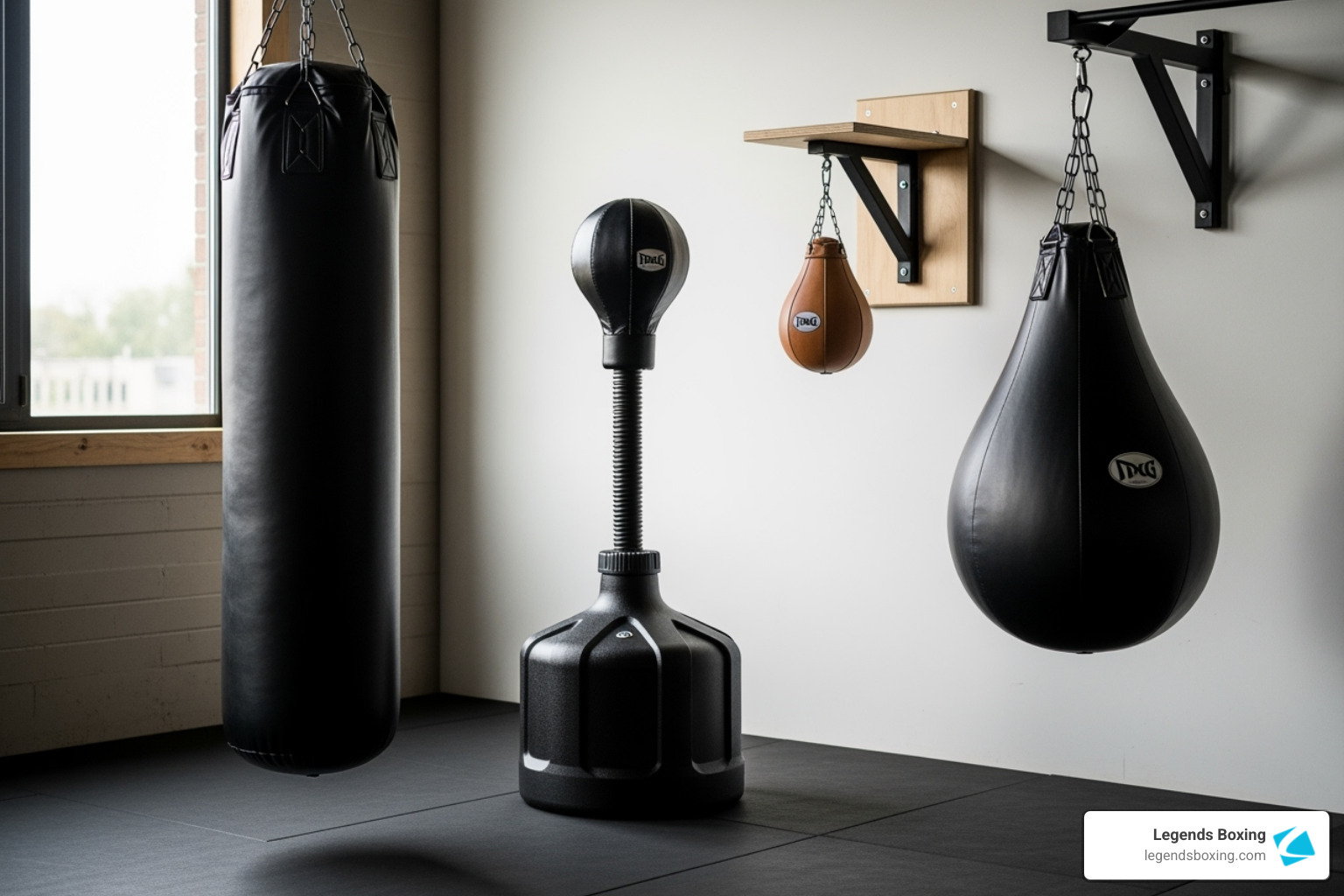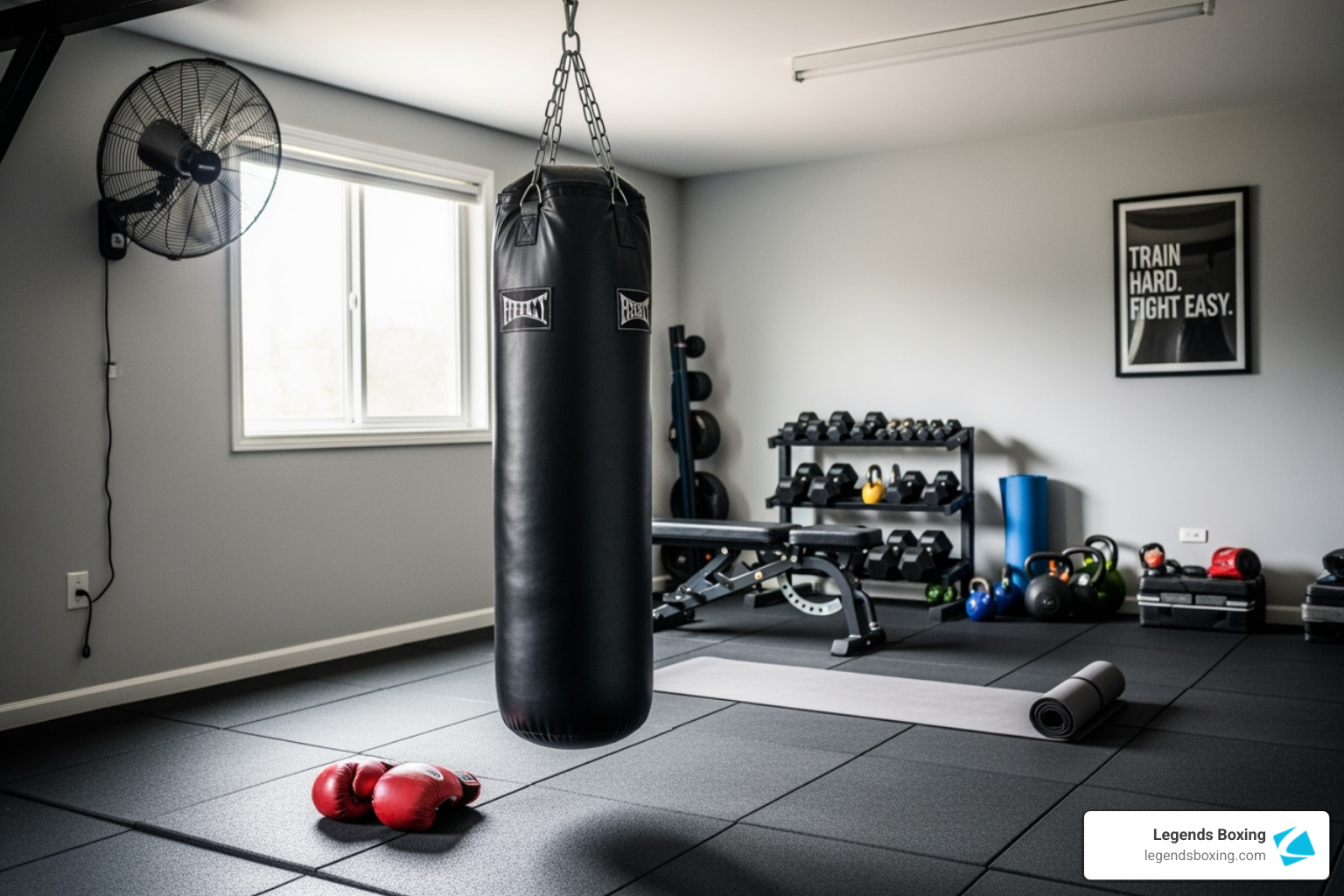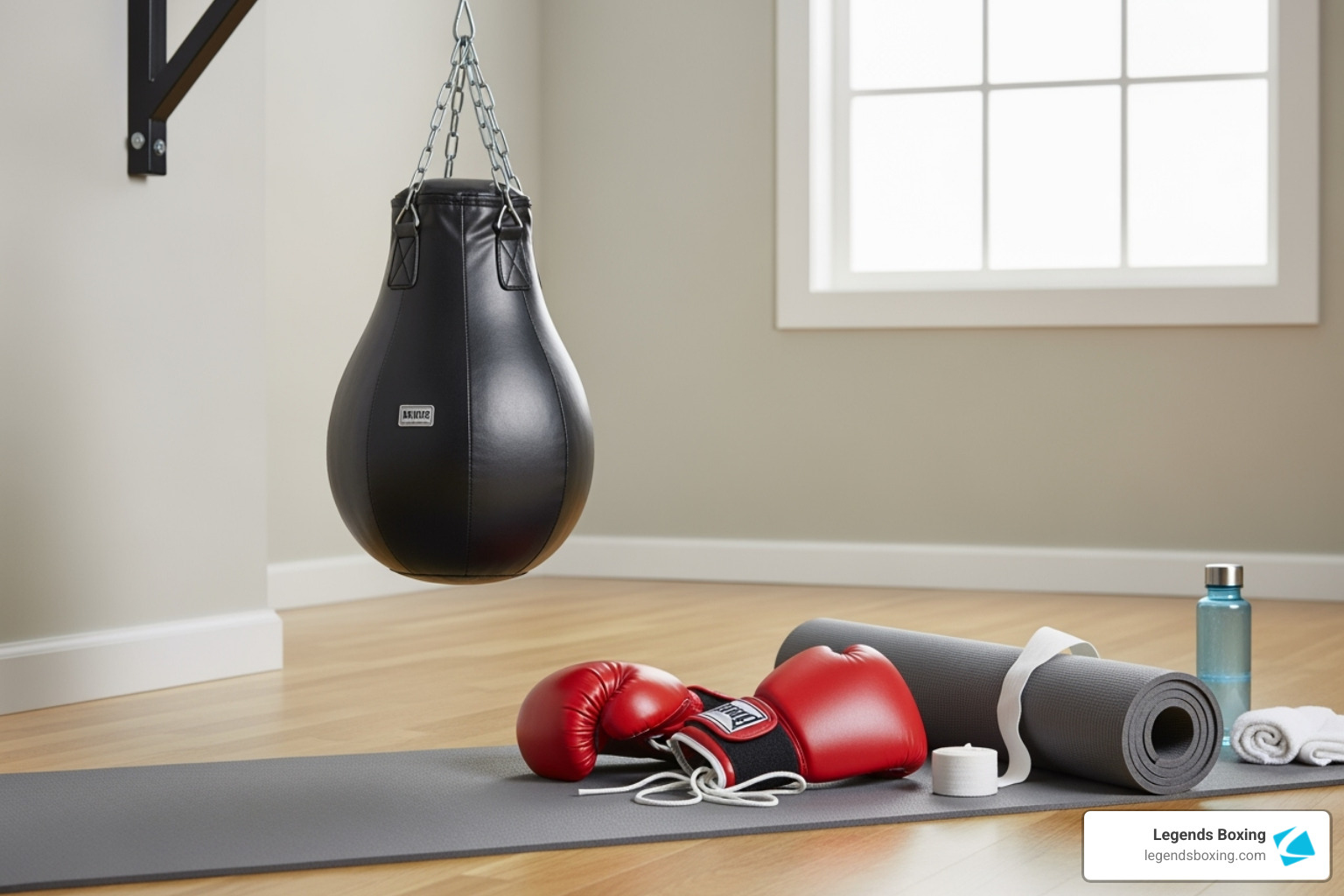From Basement to Boxing Ring: Setting Up Your Home Gym Punching Bag
Why a Home Gym Punching Bag Changes Everything
A home gym punching bag is one of the most valuable pieces of fitness equipment you can own, delivering powerful benefits for both body and mind.
Top Benefits of a Home Gym Punching Bag:
- Stress Relief: Provides an immediate outlet for frustration and tension.
- Full-Body Workout: Engages your arms, core, legs, and cardiovascular system.
- Mental Health Boost: Research shows non-contact boxing significantly reduces anxiety and depression symptoms.
- Convenience: Train anytime without gym commutes or class schedules.
- Progressive Challenge: Suitable for complete beginners through advanced athletes.
The home fitness market is booming for a reason: punching bags deliver real results. Studies show high-intensity boxing training significantly improves body fat percentage, blood pressure, and V02 max more than moderate-intensity walking. Other research highlights that non-contact boxing exercises can reduce symptoms of anxiety, depression, and PTSD.
Setting up a punching bag in your basement, garage, or spare room transforms it into a stress-busting, calorie-burning training ground. Unlike a treadmill session, every round on the bag challenges your coordination, builds power, and grows your confidence. You're not just exercising; you're learning a skill.
I'm Robby Welch, National Head Coach at Legends Boxing. I've spent years guiding members in choosing and using their home gym punching bag effectively. My experience coaching everyone from beginners to competitive fighters has shown me what works when setting up a home training space.

Common home gym punching bag vocab:
Why Add a Punching Bag to Your Home Gym?
A home gym punching bag offers a healthy outlet that transforms frustration into fitness. It's more than just stress relief; it's an investment in your physical and mental wellness.
Improve Your Physical Health
A punching bag workout is high-intensity interval training (HIIT) that strengthens your heart and lungs, burning 400-600 calories per hour. Unlike repetitive cardio, boxing is a full-body workout. Your legs generate power, your core stabilizes every movement, and your arms deliver the strikes. This functional strength translates to real life, improving coordination and building new movement patterns.
One study compared high-intensity boxing to moderate-intensity walking and found the boxing group saw significant improvements in body fat percentage, blood pressure, V02 max (oxygen efficiency), and overall vitality. Boxing delivers better results in less time while building skills like timing, precision, and footwork.
Boost Your Mental Well-being
The mental benefits of hitting a bag are just as powerful as the physical ones. The combination of physical exertion and intense focus provides an immediate release, acting as a form of active meditation. You're completely present, which helps clear your mind of daily stressors.
A 2023 study found that non-contact boxing significantly reduced symptoms of anxiety, depression, and even PTSD. The rhythmic nature of punching and the required focus help calm the nervous system and lift your mood. This training also builds mental discipline that carries over into other areas of your life.
A home gym punching bag provides these benefits on your schedule—no commute, no classes, no waiting for equipment. It's your personal tool for becoming a stronger, calmer, more focused version of yourself.
Choosing the Right Home Gym Punching Bag
Now for the fun part: picking the perfect home gym punching bag. The right choice depends on your goals, space, budget, and experience level. Think of it as finding the right workout partner—one that challenges you and helps you reach your goals.
Types of Punching Bags and Their Uses
Different bags serve different purposes. Understanding them will help you choose the right one for your home.

- Heavy Bags: These are the classic cylindrical bags for developing power and conditioning. They require sturdy installation from a ceiling or stand and provide an authentic boxing feel. They are durable but can be noisy and are not portable.
- Freestanding Bags: These bags sit on a base filled with sand or water, requiring no drilling. They are perfect for renters or those who don't want permanent installation. While easy to move, they can tip or slide with extremely powerful strikes.
- Speed Bags: These small, air-filled bags are for rhythm, timing, and hand speed, not power. They are great for building shoulder endurance and hand-eye coordination but require a dedicated platform mount and can be noisy.
- Specialty Bags: Various bags exist for specific skills. Teardrop bags are great for uppercuts and hooks. Banana bags are extra-long for kickboxing. Uppercut bags are designed for practicing uppercuts, and double-end bags (anchored to floor and ceiling) are phenomenal for timing and reflexes.
At our Bountiful gym, we have all these types so members can experience their unique benefits. For most home setups, a heavy or freestanding bag is the best starting point.
How to Choose the Right Size and Weight for a home gym punching bag
Getting the weight right is crucial. A bag that's too light will fly around, while one that's too heavy can be jarring on your joints.
A good guideline is to choose a home gym punching bag that weighs about half your body weight. A 180-pound person would start with a 90-pound bag. This provides enough resistance to build power without being immovable.
- Lighter bags (under 100 lbs) are better for speed and movement. They swing more, forcing you to work on footwork and angles.
- Heavier bags (100+ lbs) are for developing pure power. They absorb force with minimal movement, making them ideal for heavy hitters.
Beginners may prefer a lighter bag as it's more forgiving on imperfect form. If you plan to kickbox, you'll want a longer, heavier bag like a banana bag for stability.
Punching Bag Materials and Durability
The material of your bag affects its durability, feel, and price.

- Leather: The gold standard for feel and longevity, but also the most expensive. It's a great long-term investment for serious boxers.
- Synthetic Leather (PU, Vinyl): This is the sweet spot for most home users. It's durable, affordable, and easy to clean. Brands like Everlast and FITVEN offer excellent synthetic options.
- Canvas: The budget option. It's tough but can be rough on your hands and may not hold its shape as well over time.
For most people, a quality synthetic leather bag offers the best balance of performance and price.
Top-Rated Models for Your Home Gym
Here are some top-rated home gym punching bags that consistently earn high marks:
- Everlast 1910 Heavy Bag: A 100-pound classic known for durability and stability. Ideal for power training. (Approx. $399)
- FITVEN Free-Standing Punching Bag: A 70-inch tall, highly-rated freestanding option. Users praise its stability, especially on concrete. (Approx. $179.99)
- Outslayer Filled Punching Bag: A 100-pound bag renowned for holding its shape without settling. A smart investment for serious training. (Starts at $194.95)
- Hayabusa Heavy Bag: Often called a "steal" at around $159, this is a great entry-level bag for beginners who want a quality hanging option.
- MaxxMMA Speed Bag: A 30-pound bag built specifically for rapid-fire strikes to develop hand speed and rhythm. (Approx. $199)
Remember to factor in the cost of a stand or mount if needed. A cheaper bag requiring an expensive stand may not be the best value.
| Bag Type | Pros | Cons | Best For | Space Needs |
|---|---|---|---|---|
| Hanging Heavy Bag | Power development, durability, authentic feel, full-body conditioning | Requires installation, not portable, can be noisy | Power training, serious boxers, conditioning workouts | Moderate to large with swing clearance |
| Freestanding Bag | Easy setup, no installation, portable, renter-friendly | May tip with heavy strikes, less resistance than hanging bags | Beginners, apartments, cardio workouts, light technique work | Small to moderate, stable on concrete |
| Speed Bag | Improves reflexes, hand speed, rhythm, compact once mounted | Not for power, requires practice, can be noisy | Hand speed, coordination, timing, shoulder endurance | Small, needs wall/ceiling mount |
| Teardrop Bag | Versatile angles, defensive practice, joint-friendly, easier setup | Not ideal for straight power or low kicks | Varied striking angles, defensive work, close-range techniques | Moderate |
At our Cache Valley gym, we help members understand which equipment matches their goals. The right bag makes all the difference.
Installation and Setup: Hanging vs. Freestanding
You've picked your home gym punching bag; now it's time to set it up. This is about creating a safe and effective training space. Your choice between hanging and freestanding will determine the process.
Before starting, decide if you're comfortable with DIY installation or need professional help. Safety is non-negotiable. If you need guidance, places like our Cache Valley gym can help you build a strong foundation.
Hanging Your Punching Bag
A hanging bag offers an authentic feel, but proper installation is critical. A 100-pound bag creates significant force, so you must mount it to a structure that can handle the load.
- Find Support: Use a stud finder to locate a solid ceiling joist or wall stud. If you have any doubts about the structural integrity, consult a professional contractor.
- Choose a Mount: Ceiling mounts attach directly to a joist. Wall mounts are great for concrete walls or exposed studs. Heavy bag stands are a non-permanent alternative that holds the bag without drilling, but they take up more floor space.
- Installation: Use a drill, wrench, and ladder. Mark your pilot holes, securely fasten the mount with heavy-duty lag bolts, and attach your chains and swivel. A swivel is essential to prevent chains from tangling. Some bags have a bottom D-ring to anchor it and reduce swing.
- Noise: Be aware that hanging bags can be loud. The chains and impact vibrations can travel through ceilings. Rubber dampeners and lubricating the chains can help.
Setting Up a Freestanding Punching Bag
Freestanding bags are the flexible, low-commitment option, perfect for renters or anyone who wants to avoid drilling holes.
- Fill the Base: Use sand, not water. Sand is denser, providing far more stability and preventing the bag from tipping over during intense workouts.
- Consider the Floor: These bags are most stable on concrete. On carpet or mats, they may slide. A non-slip mat underneath the base can help.
- Assembly: Assembly is usually straightforward and requires no power tools. You'll attach the bag to a central pole and connect it to the base.
- Portability: The biggest advantage is portability. Simply empty the base to move the bag or take it with you when you relocate.
Taking the time to set up your bag correctly ensures a safe and effective training space for years to come.
Essential Accessories for Your Punching Bag Setup
Having the right home gym punching bag is only half the battle. To maximize your workouts and stay safe, you need a few essential accessories.

Must-Have Gear
These are the non-negotiable items you need before throwing your first punch.
- Boxing Gloves: Use proper bag gloves with dense padding to cushion your knuckles and provide crucial wrist support. They are different from sparring gloves, which are softer to protect a partner.
- Hand Wraps: Never hit the bag without them. These wraps protect the small bones in your hands, offer additional wrist support, and absorb sweat to keep your gloves fresh.
- Jump Rope: A boxer's secret weapon for warming up. It improves footwork, coordination, and cardiovascular fitness quickly and affordably.
- Floor Mat: A sturdy mat reduces noise, prevents a freestanding bag from sliding, and provides a more comfortable surface for footwork, especially on hard floors.
Optional but Recommended Add-ons
These items can take your training to the next level.
- Punching Bag Stand: Essential if you choose a hanging bag but cannot drill into your ceiling or walls.
- Speed Bag Platform: A necessary wall mount to provide the rebound surface for a speed bag.
- Double-End Bag Anchors: Specific anchors for the ceiling and floor are needed to set up this valuable tool for timing and accuracy.
- Protective Headgear: Important if you plan to incorporate any partner drills or light contact.
- Gym Timer: A simple timer or phone app helps structure your rounds and rest periods, keeping your workout disciplined and effective.
Equipping yourself properly protects you and makes training more enjoyable. If you're near our Jordan Landing gym, stop by for expert guidance on using this equipment.
Frequently Asked Questions about Home Gym Punching Bags
Setting up a home gym punching bag brings up a lot of questions. Here are answers to the most common ones.
What is the best type of home gym punching bag for beginners?
A freestanding punching bag is often the best choice for beginners. The setup is simple—no drilling or contractors required—which is ideal for renters or those just starting. They are stable enough for learning proper form without the wild swing of a hanging bag. If you prefer a hanging option, the Hayabusa Heavy Bag (around $159) is a quality, budget-friendly choice. The most important factor is choosing a bag that fits your space and that you will use consistently.
How much should I expect to spend on a punching bag?
Expect to spend between $80 to $400+. Prices vary based on type, material, brand, and size. Synthetic leather bags offer the best value for most home users. Here are some examples:
- Budget-friendly: The Fairtex Banana Bag ($139.99) is great for kickboxing.
- Mid-range: The FITVEN Free-Standing Punching Bag ($179.99) and Outslayer Filled Punching Bag ($194.95+) offer excellent quality for the price.
- Premium: The Everlast 1910 Heavy Bag ($399) is a top-tier investment for dedicated training.
Don't forget to budget for essential accessories like gloves, wraps, and a potential stand or mount.
Can I use a punching bag for kickboxing?
Yes, absolutely. The key is to select the right type of bag. Banana bags, like the Fairtex Banana Bag, are purpose-built for kickboxing with their extra length. Longer heavy bags (5-6 feet, 100+ lbs), such as the Outslayer Filled Punching Bag, also work well, especially if anchored to reduce swing. Taller freestanding bags, like FITVEN's 70-inch model, are a great option if you can't hang a bag. For any kickboxing bag, ensure the base is filled with sand for maximum stability.
Conclusion: Your First Round Awaits
You've made it through the entire guide—and honestly, that's half the battle right there. Now you know that a home gym punching bag isn't just a piece of equipment gathering dust in the corner. It's a powerful tool for burning calories, building real strength, and releasing the kind of stress that no amount of deep breathing can touch. You understand how boxing can lift your mood, sharpen your focus, and give you a sense of accomplishment that carries into every other part of your life.
We've walked through choosing between heavy bags and freestanding options, figured out what weight works for your body and goals, and talked about whether you're drilling into ceiling joists or filling a base with sand. You know the difference between leather and synthetic materials, and you've got a solid list of top-rated bags that won't let you down. You even know which accessories will protect your hands and keep your floors (and your downstairs neighbors) happy.
Setting up your home gym punching bag transforms more than just your space—it transforms your routine. No more excuses about gym hours or commute times. No more waiting for equipment. Just you, your bag, and the freedom to train whenever the mood strikes or whenever life demands you hit something (in the healthiest way possible).
But here's the thing: having the bag is just the beginning. The real journey—from throwing awkward first jabs to flowing through smooth combinations—happens when you learn proper technique and push yourself with structured workouts. That's where expert coaching makes all the difference.
At Legends Boxing, we've built our entire approach around making boxing accessible and effective for everyone, regardless of experience. We combine authentic boxing techniques with conditioning and core work that delivers real results. Our coaches know how to meet you where you are and push you to where you want to be.
Your bag is set up. Your gloves are ready. Now it's time to learn what to do with them. Book a free workout with us today! Your first round is waiting—and trust me, it's going to feel amazing.






